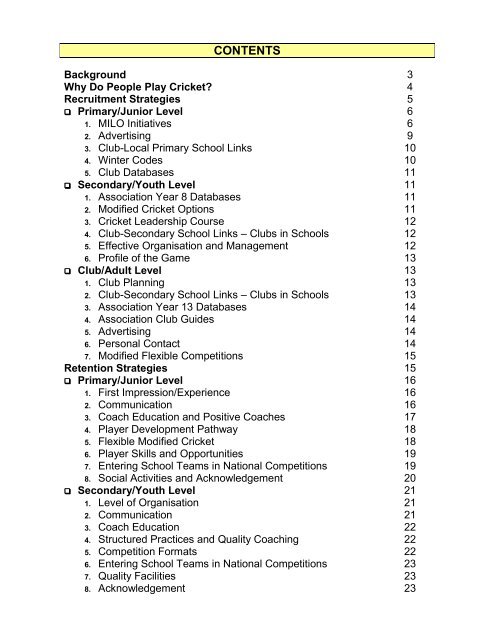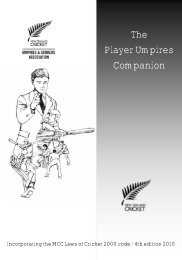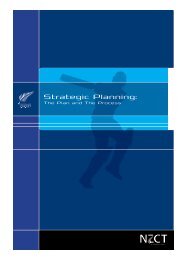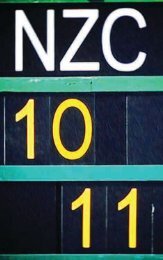Player Recruitment - New Zealand Cricket
Player Recruitment - New Zealand Cricket
Player Recruitment - New Zealand Cricket
- No tags were found...
You also want an ePaper? Increase the reach of your titles
YUMPU automatically turns print PDFs into web optimized ePapers that Google loves.
CONTENTSBackground 3Why Do People Play <strong>Cricket</strong>? 4<strong>Recruitment</strong> Strategies 5 Primary/Junior Level 61. MILO Initiatives 62. Advertising 93. Club-Local Primary School Links 104. Winter Codes 105. Club Databases 11 Secondary/Youth Level 111. Association Year 8 Databases 112. Modified <strong>Cricket</strong> Options 113. <strong>Cricket</strong> Leadership Course 124. Club-Secondary School Links – Clubs in Schools 125. Effective Organisation and Management 126. Profile of the Game 13 Club/Adult Level 131. Club Planning 132. Club-Secondary School Links – Clubs in Schools 133. Association Year 13 Databases 144. Association Club Guides 145. Advertising 146. Personal Contact 147. Modified Flexible Competitions 15Retention Strategies 15 Primary/Junior Level 161. First Impression/Experience 162. Communication 163. Coach Education and Positive Coaches 174. <strong>Player</strong> Development Pathway 185. Flexible Modified <strong>Cricket</strong> 186. <strong>Player</strong> Skills and Opportunities 197. Entering School Teams in National Competitions 198. Social Activities and Acknowledgement 20 Secondary/Youth Level 211. Level of Organisation 212. Communication 213. Coach Education 224. Structured Practices and Quality Coaching 225. Competition Formats 226. Entering School Teams in National Competitions 237. Quality Facilities 238. Acknowledgement 23
Club/Adult Level 241. Planning and Organisation 242. Communication – Club Liaison 243. Coach Education 244. Youth Teams or Academy 245. Structured Practices and Quality Coaching 256. Consistent Selection Process 257. Quality Facilities 258. Social Activities and Acknowledgement 259. Club Environment 26Conclusion 26Acknowledgement 272
BACKGROUNDPLAYER RECRUITMENT and RETENTION“It is at the junior level that the future players and fans of sport are tobe found, with officials realising that without a strong player basethere will be no champions coming through to the top over which tofight. Children are now seen as the greatest commodity and sportsadministrators are realising they can no longer be complacent andrely on family association for recruitment and development.”[Fiona Purdon, ‘A Battle for Sporting Supremacy is Being Fought Out Across theSchoolyards of Queensland’, Brisbane Courier-Mail, April 17, 2000]‘Traditionally, new club members have been the sons and daughters,or brothers and sisters of existing club members. This is not aguaranteed source of new junior cricketers and other sources shouldbe explored.’[Yorkshire <strong>Cricket</strong> Board]“<strong>Cricket</strong> clubs need to recognise the work that goes on in sport inschools, and not just wait for children to leave school and expectthem to come and join up. There are so many activities for youngpeople these days, cricket can’t sit back and say “They will come tous”, you’ve got to go out and get them.”[Kate Hoey, UK Minister for Sport in ‘The <strong>Cricket</strong>er’, October 2000, p17]Attracting, developing and keeping players are key to the ongoing health andwellbeing of cricket clubs and to the game within primary and secondaryschools. At the junior/primary school level of the game creating an awarenessand/or interest in the game as a prelude to recruiting players is critical. It isessential that the first experience that youngsters have is a well organisedone with the emphasis being on fun and skill development if they are tocompete in the game and enjoy their involvement. So the focus at this level ofthe game is one of RECOGNITION and RECRUITMENT with the object ofthe current MILO and conventional cricket programmes being to ensure theirRETENTION. A strong commitment of parents and teachers as coaches,administrators and supporters is essential to this process.At the secondary school/youth and the adult/club levels the emphasis is verymuch on player RETENTION. How do we keep players in the game? This iswhere cricket clubs and secondary schools need to be fully aware of theinfluences impacting on players and as such there is a need to ensure that3
INFRASTRUCTURES are in place to support and service their interests,abilities and needs. Organised practices, quality coaching, appropriatecompetitions with modified formats catering for both the competitive and therecreational player, and flexible scheduling all need careful consideration inthe retention of today’s players. Failure to recognise change and adapt toprevailing demands is not a recipe for sustainability. It should be noted thatcurrently 44% of all adults participating in the game are playing in modifiedaction forms of the game [eg. midweek twilight, action or corporate, modifiedcricket competitions such as Super 8s, Twenty20 or variants of these].The aim of this SCHOOL SUPPORT and CLUB ASSIST resource is toprovide school and club administrators with a set of guidelines aboutRECRUITING and RETAINING players. While there are numeroussuggestions to achieve these objectives, there is no substitute within a club orschool for effective organisation, a clear player pathway serviced by qualitycoaches and coaching, and access to sound practice and playing facilitiesand equipment. There are no short cuts. Strong links need to be built withcontributing community schools and new players need to be made welcomeand catered for. This takes time, effort and a large dose of volunteerenthusiasm.WHY DO PEOPLE PLAY CRICKET?To be able to RECRUIT new players to the game and therefore newmembers to your cricket club; and RETAIN existing members it is importantto understand the REASONS why people play cricket. Research identifies themain reasons for people playing cricket include:• Making new friends• Building self-confidence• Enjoying the feeling of belonging to a team• Having fun and enjoying themselves• Having a passion for cricket• The rewards and recognition• The competitive challengeThe reasons why males and females play is also a recruitment and retentionconsideration for schools and cricket clubs as they have a different order ofpriority, although for both their major reason is to have fun and enjoythemselves.4
REASONS FOR PLAYING CRICKETMAIN REASONS WHY MALESPLAY CRICKET[in rank order]1. To have fun2. To do something they are good at3. To learn new skills4. To be physically fit5. To improve their skills6. To compete7. The challenge8. To be in a team9. The excitement10. The action‘Males tend to be more orientatedtowards skill development andcompetition’MAIN REASONS WHY FEMALESPLAY CRICKET[in rank order]1. To have fun2. The team spirit3. To be in a team4. The teamwork5. To be physically fit6. To learn new skills7. To improve their skills8. To get exercise9. The action10. The excitement‘Females tend to be more focused ontheir involvement with the team and onskill development’Adapted from Cadeyrn Gaskin, 2000, Occupying the Crease: The Influence of Parents andCoaches on <strong>New</strong> <strong>Zealand</strong> Adolescent Participation in <strong>Cricket</strong>, Master in Business Studies inManagement thesis, Massey University, p128RECRUITMENT STRATEGIESThe main focus of the <strong>New</strong> <strong>Zealand</strong> <strong>Cricket</strong> NATIONAL DEVELOPMENTPROGRAMME is ‘about getting individuals to play and stay in the game’. Theprogramme has two key OBJECTIVES:1. The first objective is ‘GAME’ focused and is to INCREASE THE LEVELS OFPARTICIPATION in the game [QUANTITY ie. players and volunteer supporters –coaches, umpires, scorers, administrators]2. The second objective is ‘PLAYER/PARTICIPANT’ focused and is to SUSTAINTHESE LEVELS through BETTER SERVICING THE PLAYERS/PARTICIPANTS sothat they stay in the game [QUALITY ie. club and school structures andorganisation, competitions, coaching, skill development, improved facilities,talent identification, volunteer education and recognition]To this end <strong>New</strong> <strong>Zealand</strong> <strong>Cricket</strong> has invested in the establishment of anetwork of CRICKET DEVELOPMENT OFFICERS [Community <strong>Cricket</strong>Coordinators, Club Managers, MILO Summer Squad] to deliver a wide rangeof INITIATIVES to attract, develop and keep players in the game. These areaimed at addressing the five key DEVELOPMENT STRATEGIES –RECOGNITION, RECRUITMENT, RETENTION, RESTRUCTURING andRESOURCING – each of which is intended to GROW and SUSTAIN thegame within primary schools, secondary schools and cricket clubs [seediagram: ‘Development Levels and Strategies’].5
In addition, to these <strong>New</strong> <strong>Zealand</strong> <strong>Cricket</strong> strategies, all of which are availablethrough the <strong>Cricket</strong> Development Officers in each cricket association, schoolsand clubs should also be looking to increase their player numbers throughactive RECRUITMENT. The following are some RECRUITMENTSTRATEGIES that schools and clubs can use to increase PLAYERREGISTRATIONS and elevate the PROFILE of cricket within their localcommunities.PRIMARY/JUNIOR LEVEL1. MILO INITIATIVESArrange through your local cricket association for the MILO SUMMERSQUAD to visit your primary school, or as a cricket club to visit nominatedprimary schools within your community. At each school the MILO SummerSquad will run MILO CRICKET SKILLS AWARENESS LESSONS [Years1-6] and/or the NEW ZEALAND CRICKET SKILLS CHALLENGE [Years7-8] to provide children with a fun ‘taste’ of the game along withinformation about how to register to play cricket either for their school orthe local cricket clubNEW ZEALAND CRICKETSKILLS CHALLENGEThe <strong>New</strong> <strong>Zealand</strong> <strong>Cricket</strong> Skills Challengeis a structured series of lessons whichallows Year 7 and 8 students to testthemselves in a number of fundamentalcricket skill areas against a set of easilymeasurable standards and achieve abronze, silver or gold skill award inrecognition of their level of performance.The Challenge is an effective, fun way topromote cricket in schools.6
DEVELOPMENT LEVELS and STRATEGIESLEVELSSTRATEGIESPRIMARY[MILO INITIATIVES]SECONDARY[SCHOOL SUPPORT]CLUB[CLUB ASSIST]RECOGNITION Communication by MILOSummer Squad with schools– flyers, packs, manuals, CD-Roms, partnershipagreements MILO cricket skills awarenesslessons and holiday clinics NZ <strong>Cricket</strong> Skills Challenge Communication by MILOSummer Squad andCommunity <strong>Cricket</strong>Coordinators with schools –partnership agreements Communication by MILOSummer Squad andCommunity <strong>Cricket</strong>Coordinators with clubs -partnership agreements MILO holiday clinicsRECRUITMENT MILO Have-A-Go <strong>Cricket</strong> MILO Kiwi <strong>Cricket</strong> Quikhit Backyard <strong>Cricket</strong> MILO Cup and MILO Shieldnational primary schoolcompetitions <strong>New</strong> shorter version, flexible,game formats eg. Slog Sixes,Super 8s, Twenty20, Quikhit Backyard <strong>Cricket</strong> Gillette Cup and <strong>New</strong> <strong>Zealand</strong>Community Trust Cupnational secondary schoolsenior girls’ and junior boys’competitions MILO Have-A-Go <strong>Cricket</strong> MILO Kiwi <strong>Cricket</strong> Backyard <strong>Cricket</strong> <strong>New</strong> shorter version, flexible,game formats eg, Super 8s,Twenty20, Quikhit National club competitionRETENTION MILO Have-A-Go <strong>Cricket</strong>Coaches MILO Kiwi <strong>Cricket</strong> Coaches Getting Started in Coaching a<strong>Cricket</strong> Team Coaches Level 1 Coaches <strong>Player</strong> databases Getting Started in Coaching a<strong>Cricket</strong> Team Coaches Level 1 and 2 Coaches <strong>Cricket</strong> Leadership Course School Support initiatives <strong>Player</strong> databases MILO Have-A-Go <strong>Cricket</strong>Coaches MILO Kiwi <strong>Cricket</strong> Coaches Getting Started in Coaching a<strong>Cricket</strong> Team Coaches Level 1 and 2 Coaches Club Assist initiatives <strong>Player</strong> databasesRESTRUCTURING <strong>Player</strong> pathway – modifiedcricket options eg. Quikhit,Slog Sixes MILO Have-A-Go <strong>Cricket</strong>programme <strong>New</strong> <strong>Zealand</strong> <strong>Cricket</strong> SkillsChallenge <strong>Player</strong> pathway – modifiedcricket options eg. Quikhit,Slog Sixes Year 9/10 fixtures andregional competitions Senior interschool fixturesand regional competitions <strong>Player</strong> pathway – modified[eg. Quikhit] and flexible [eg.Village <strong>Cricket</strong>] cricketoptions MILO Have-A-Go <strong>Cricket</strong>programme MILO Kiwi <strong>Cricket</strong> programmeRESOURCING MILO Summer Squad Promotional giveaways MILO information andadministration booklets Coaching manuals Coaching videos/DVDs Educational CD-Roms Artificial pitch funding Community <strong>Cricket</strong>Coordinators Coaching manuals Artificial pitch funding School support advice andguidance resources• Health Check• Strategic Planning• School Clubs• Local GameCoordinators• Running a <strong>Cricket</strong> Club• Financial Management• Coaches and Coaching• Coach Education• Practice Plans• Funding Schemes• Turf Pitch Management• Artificial Pitches andPractice Nets• Modified Game Formats• Game Understanding• <strong>Player</strong> <strong>Recruitment</strong> andRetention• Volunteers• School-Club Links Community <strong>Cricket</strong>Coordinators MILO Summer Squad MILO information andadministration booklets Coaching manuals Coaching videos/DVDs Artificial pitch funding Club Assist advice andguidance resources• Health Check• Strategic Planning• School Clubs• Local GameCoordinators• Running a <strong>Cricket</strong> Club• Financial Management• Coaches and Coaching• Coach Education• Practice Plans• Funding Schemes• Turf Pitch Management• Artificial Pitches andPractice Nets• Modified Game Formats• Twenty20• Game Understanding• <strong>Player</strong> <strong>Recruitment</strong> andRetention• Volunteers• Club-School Links7
[eg. MILO HAVE-A-GO CRICKET, MILOKIWI CRICKET, MILO CUP and SHIELD,QUIKHIT, junior hardball cricket].The best ways of following up the interestand enthusiasm created by the MILOSummer Squad visits are: DIRECT CONTACTTelephone and talk to the parents ofthose youngsters who indicated theyare keen to play and explain how,when and where they can participate.A less effective way is to email orwrite to the parents of interestedchildren. REGISTRATIONSCollect player enrolments as soon as possible after the school visits.For school teams gather the keen players together and collect theirdetails. For club teams have a specific registration time. Experienceshows for younger players thatsuch registrations are best donethrough the school using theassistance and expertise of theschool office rather than being leftto a registration day at a cricketclub. COME and TRY DAYIf you are having a registration daythere may be an opportunity to setup a modified game or series of skillsstations to allow potential newparticipants to ‘come and try’ cricket before they enrol. Encouragecurrent junior players to bring along their friends to take part. This couldbe set up around a sausage sizzle to make new players and theirfamilies feel welcome. Remember parents these days are morediscerning and want to make sure their children are making the rightchoice if they are going to commit themselves to supporting theirchildren’s participation for a full season.8
2. ADVERTISINGYour school or cricket club is just one of many competing for youngsters’time. What makes school cricket or your cricket club special or attractivefor youngsters? Promote the positive aspects thatbelonging to your junior cricket club offersyoung players.In order to recruit players effectively,schools and cricket clubs need toemphasise the opportunities that playingcricket provides for social contact, for asense of personal satisfaction throughtheir development, meeting challengesand enjoyment.Basic forms of advertising within the localcommunity will help you spread the wordabout the game and how youngsters canget involved. You may like to consideradvertising in some or all of the following:• Local newspapers or radio• Local noticeboards[eg. schools, libraries,leisure centres]• Local shop windows[eg. supermarkets, cornerdiaries]• Local cricket associationnewsletters and/orhandbooks• School newsletters• Postersschool cricket orATTRACTIONS OF PLAYINGCRICKET AT SCHOOLOR FOR A CLUB• <strong>New</strong> friendships• <strong>New</strong> skills• Sense of belonging• Rewards of involvement• Exciting opportunities• Competition• Social occasions• Quality coaching• Organised practices• Exciting matches• Effective organisation• <strong>Cricket</strong> club flyers orinformation sheets whichcan be handed out at school class or assembly visits, ordistributed in letter boxes within the club’s local community• School, cricket club or cricket association websitesDon’t forget that one of the strongest and most effective forms of localadvertising is by personal recommendation – WORD OF MOUTH9
3. CLUB-LOCAL PRIMARY SCHOOL LINKSTraditionally, new junior members have been the son’s and daughters ofexisting club members or cricketers. Today this is not a guaranteed sourceof new juniors and other sources should be explored. One of the best waysto ensure a steady stream of new juniors is via local community PRIMARYSCHOOLS.Many primary schools have MILO Kiwi <strong>Cricket</strong> gear which means theirchildren have the chance to play cricket and they may now be looking forsomewhere to play it out of school … your cricket club for example!Additionally, there will be many children in schools where cricket is notplayed, who would welcome the opportunity to be introduced to the game.By liaising with your local cricket association your cricket club can arrangefor their MILO SUMMER SQUAD to visit select local schools within yourcatchment area. As part of their structured programme they will hand outinformation [ie. pamphlets, flyers, posters] about where your club is andhow to become a member. Ideally, a club member may like to assist withthis process and in doing so be able to reinforce the benefits of joiningyour cricket club.In addition, cricket clubs can also try some of the following:• PostersAdvertise your junior section by asking for posters to be displayed onschool notice boards.• AssembliesMany schools would welcome a confident player or club official totalk about cricket and joining your cricket club in their assemblies.• CoachingYou may have a qualified coach or coaches who you could offer tohelp school staff deliver cricket to their students. This could be eitherat the school or at the club.• FestivalsInvite a number of local schools to play in a modified cricket or skillsfestival on your cricket club ground. Maybe have a sausage sizzle.Use the festival as a way to promote your club’s MILO Have-A-Go<strong>Cricket</strong>, MILO Kiwi <strong>Cricket</strong> or hardball cricket programmes.4. WINTER CODESEstablish an agreement with a winter sport[s] to allow the exchange ofmailing lists and advertise in each other’s newsletters at appropriate timesin the season is also a great way of increasing registrations. It is quitecommon for children who play a winter sport together to try and find asummer sport they can play together as well.10
5. CLUB DATABASESThe establishment of a detailed cricket club DATABASE allows clubs tokeep an accurate track of their members. Make sure that the database isused prior to the start of each season to send out INVITATION LETTERSor EMAILS informing existing players of upcoming club events andwelcoming them to register again for the upcoming season. If your clubhas the computer capability such registrations can be done online.Once registrations are received follow-up any past players who have notregistered, either with a personal visit or by telephone to ascertain if theyintend playing again this season.The health and wellbeing of cricket within schools and clubs is dependent uponthem creating and maintaining an accurate record or DATABASE of membersSECONDARY/YOUTH LEVEL1. ASSOCIATION YEAR 8 DATABASESA number of cricket associations now collect data about their Year 8 juniorcricketers and are able to provide secondary schools with a list ofprospective cricketers and any of their parents keen to be involved incoaching and/or managing teams. This is aimed at improving the transitionfor players between primary/intermediate school and secondary school.Secondary schools need to contact their local cricket association to see ifthey have such a database of new entrants who play cricket.2. MODIFIED CRICKET OPTIONSAbout 22% of secondary school cricketers play some form of modifiedcricket. Many do so because they want to play a midweek, shorter versiongame with no commitment to practise. Schools and clubs should consideroffering Twenty20 or Super8s to attract youth recreational cricketers.Two further modified versions of the game, designed by <strong>New</strong> <strong>Zealand</strong><strong>Cricket</strong> to encourage greater participation, include QUIKHIT and SLOGSIXES: QUIKHIT - is an 8 a-side, girls’ only, 12 over modified cricket game.It uses special, coloured, lightweight team equipment, which can bepurchased from <strong>New</strong> <strong>Zealand</strong> <strong>Cricket</strong>, and has been devised for 11-15 year old girls to act as a transition between MILO Kiwi <strong>Cricket</strong>and hardball cricket. SLOG SIXES - is 6 a-side version of the game which can be used inphysical education classes, or as a lunchtime competition. It is anaction-packed game that can be played on any reasonably flat11
surface, in a limited time frame [30-60 minutes], with a minimum ofequipment and only needs 6 players of any ability or skill level tomake up a team.3. CRICKET LEADERSHIP COURSEThis is another <strong>New</strong> <strong>Zealand</strong> <strong>Cricket</strong>initiative, and is run in secondaryschools by the Community <strong>Cricket</strong>Coordinators with Year 12 PhysicalEducation students who can gain 3NCEA credits if they successfullycomplete the achievement standard2.7, or with Year 13 students doing asports management course, or asports option/elective. This can beused to involve club coaching12CCC and senior secondary school students as part ofthe ‘<strong>Cricket</strong> Leadership Course’ running coachingsessions in a local community primary schoolpersonnel and/or introduce a high profile club player to the students aspart of the course and to build strong links with a local secondary school.This course is aimed at increasing the profile of the game with seniorstudents and providing them with the skills to make a contribution as acoach and/or umpire assisting organise cricket within their school or localcommunity primary/intermediate schools.4. CLUB –SECONDARY SCHOOL LINKS – ‘CLUBS IN SCHOOLS’There are numerous opportunities for CRICKET CLUBS as the ‘hub’ ofcricket within a community to involve themselves with local secondaryschools to assist with the development of the game and its players, andensure that these young cricketers have a viable outlet to play the gamewhen they leave school. Good club-school links can provide young peoplewith positive experiences and ease their transition from school to clubcricket. Successful club-school links have major benefits for both groups,but are an especially important RECRUITMENT STRATEGY for cricketclubs in terms of sustaining and strengthening their membership base [Seethe ‘School Support’ and ‘Club Assist’ resource ‘Effective Club-Schooland School-Club Links’ on how to build strong club-school linkages].5. EFFECTIVE ORGANISATION and MANAGEMENTThere is no substitute for cricket as a sport in a secondary school beingWELL ORGANISED, EFFECTIVELY PLANNED and EFFICIENTLYMANAGED. In most secondary schools responsibility for this lies with theDIRECTOR or TEACHER-IN–CHARGE OF CRICKET.If cricket is well run and administered within a secondary school, thenstudents, teachers and parents will want to be involved. This creates asporting environment in which they know what is happening and why, and
what is expected of them and why. The availability of QUALITYCOACHES who receive strong support and recognition is also a majordrawcard as are clear team selection policies, high standards andexpectations, sound practice and coaching programmes and access togood facilities and equipment for players6. PROFILE OF THE GAMEThe level of effectiveness of cricket in a secondary school is frequently areflection of the level of interest and attitude to cricket by the Principaland/or senior management. If this is significant then the game will bepromoted within the school through coach support, team and playerrecognition, and the provision of quality facilities and equipment. Theprofile of the game will besuch that students will want tobe part of it, as they willreceive positive reinforcementfor their involvement. This isone of the key reasons for thepopularity of the game inmany traditional boys’ andgirls’ schools.CLUB/ADULT LEVELNEW PLYMOUTH GIRLS’ HIGH SCHOOLWhy is cricket so successful at NPGHS?• The school promotes playing cricket as a ‘fun thingto do’• <strong>Cricket</strong> is considered a significant sport within theschool structure• The success of the 1 st XI team is acknowledgedand valued by the school[Women’s Development Meeting, Christchurch, 2006]1. CLUB PLANNINGAppoint a club committee to develop a RECRUITMENT PLAN detailing arange of STRATEGIES, including where, when and how these are going tobe implemented.Set up a LIAISON OFFICER in the club to liaise with schools in thecommunity, including developing close ties with their DIRECTOR OFCRICKET or TEACHER-IN-CHARGE OF CRICKET, and provide supportfor the entry, orientation and accommodation of new players into the club.2. CLUB –SECONDARY SCHOOL LINKS – ‘CLUBS IN SCHOOLS’The major source of potential new players for a cricket club lies in theircommunity secondary school[s]. It is therefore critical to the longevity ofcricket clubs that they build strong links with their local secondaryschool[s], so they are in the best position to recruit school cricket leaversinto their ranks. There are many ways of establishing these linkages [For arange of possibilities, see the ‘School Support’ and ‘Club Assist’ resource‘Effective Club-School and School-Club Links’].There is no doubt that the presence within a school of, either a CCCacting on behalf of a cricket club, or club personnel themselves, is13
advantageous to enhancing these relationships and facilitating thetransition of school cricket leavers into club cricket.3. ASSOCIATION YEAR 13 DATABASESAs for Year 8 cricketers a number of cricket associations also compileYear 13 databases of cricket players leaving secondary school. <strong>Cricket</strong>clubs should use these databases to contact prospective cricketers livingin their catchments and invite them to join their club. This can be doneeither by personal contact, telephone, email or letter. Don’t underestimatethe direct face-to-face approach.4. ASSOCIATION CLUB GUIDESSeveral cricket associations have producedexcellent club guides for secondary schoolleavers profiling each of their cricket clubs,These are distributed to school leavers toprovide them with quality information abouteach club’s history, playing and coachingprogrammes, facilities and contact detailsin order to provide them with all possibleoptions as they move from school to clubcricket.5. ADVERTISINGMany cricket clubs advertise their contactdetails in local government publications,cricket association handbooks, and in somecases, the yellow pages of telephone directories. Other ways to promotethe benefits of joining a cricket club as well as displaying their contactdetails, registration days and training times include:• An ‘Information Board’ set up in a prominent roadside positionat a club’s ground• Posters or flyers placed in local shops or distributed incommunity letter boxes• Local newspapers• School newsletters• Club or association websites6. PERSONAL CONTACTA frequent source of new club members is through them being introducedby current members. Encourage current players to actively recruit theirfriends or work colleagues. Be proactive and write, email or telephone14
cricketers that you hear may be moving to your community and invite themto join your cricket club.Canvas secondary school players to ascertain their desire to play for yourcricket club. Go to school assemblies and talk to those interested aboutthe advantages of joining. Remember young school leaver cricketersusually like to go where their friends want to play so target the whole groupof players not just individuals.Keep a record of previous junior players. As they are due to finishsecondary school contact them to ensure they return to the senior club.Contact past players to see if they want to be involved with new modifiedshortened versions of the game that may be on offer, such as Twenty20cricket or flexible village cricket played on Sundays every 4-5 weeks duringthe summer, or be on a list of ‘stand-by’ players who may not want to playon a regular basis, but who are available to fill-in occasionally throughoutthe season.7. MODIFIED FLEXIBLE COMPETITIONSIncreasingly, societal change has for varying reasons influenced players toselect the format of the game that best suits their TIME AVAILABILITY.As a result nearly half of all adult cricketers now participate in someshorter version, modified cricket. Such competitions are often midweek,provide a ‘pay-as-you-play’ option, and make no demands for practices,uniform or the need to play every week. Clubs and cricket associationsneed to understand these trends and try and accommodate participantneeds with a range of flexible cricket options if they want to recruit newplayers, retain current players, and attract back ex-players.RETENTION STRATEGIESThe pivotal strategy of the national development programme is RETENTION.This is about providing the appropriate support, services and opportunities todevelop and keep players in the game and should be the main objective ofschools and cricket clubs.Many players play the game and then for varying reasons they give up ordropout. Why do players discontinue the game? Research shows that themain reasons players DISCONTINUE playing cricket include: competitionfrom other activities, concerns about lack of ability to play the game soparticipants fear failure or injury, lack of involvement in the game, the timeinvolved in playing the game, and dissatisfaction with the coach in terms ofthe lack of coaching and/or coach support and encouragement.15
Many of these ‘negatives’ about the game and player development can beaddressed through proactive RETENTION STRATEGIES. Schools andclubs need to be aware of how some perceive cricket and ensure that theymeet the needs, interests and abilities of all those keen to participate in thegame. More time and energy should be spent on keeping players than oncontinuously chasing new ones. The health and wellbeing of the game inschools and cricket clubs are dependent upon it!PRIMARY/JUNIOR LEVEL1. FIRST IMPRESSION/EXPERIENCEJunior cricket is about fun, enjoyment, friendship, participation, skilldevelopment and competition. It is the foundation for <strong>New</strong> <strong>Zealand</strong>’s mainsummer game.The main motives for young children to play cricket are to have fun, makenew friends, socialise and learn new skills. Schools and clubs mustunderstand this and make every effort to ensure the first experience of thegame for children and their parents is a POSITIVE one. Create a friendlyenvironment in which both children and parents are made to feel welcomeand are given plenty of PRAISE and ENCOURAGEMENT for theirinvolvement.A child’s first impression of a sport is vital and the MILO Have-A-Go<strong>Cricket</strong> and MILO Kiwi <strong>Cricket</strong> programmes have been set up so thateveryone has the chance to display their skills in every session/game.Children love the times when it is their turn to bat, to bowl and towicketkeep as well as the chances they get to catch and throw the ball,and to laugh and have fun with their friends.2. COMMUNICATIONCommunication is the key to retain players and their families. For newplayers and parents make sure they are provided with clear guidelines andexpectations, in terms of when and where games or practices arescheduled, what players require by way of clothing [including caps or hats],footwear, equipment [if necessary], sunscreen food and drink, and howparents can become involved as VOLUNTEERS, either as coaches orassisting with general supervision, scoring, umpiring, transport and/orsocial activities. Make sure they are included and made to feel part of thegame in your school or club.For existing players, don’t assume that they will just turn up and registeragain; telephone, email and/or send letters to players and their parents,and/or teachers prior to the beginning of the season to remind them aboutthe start of the season, the date and venue of registration as well as the16
playing options available. A letter or email could also have a registrationform attached.3. COACH EDUCATION and POSITIVE COACHESEncourage parents and teachers to trainas COACHES at the level of their children.<strong>New</strong> <strong>Zealand</strong> cricket has a six stepCOACH DEVELOPMENT PATHWAYwhich is aligned with the playerdevelopment pathway. The first threeintroductory courses are aimed as parentsand teachers. They are free, nonexaminableand delivered regularly by theCCCs in each cricket association.Schools and clubs should take advantageof these COACH EDUCATIONopportunities for their parents and/orteachers and ensure all those involvedwith organising and running MILO Have-A-Go <strong>Cricket</strong>, MILO Kiwi <strong>Cricket</strong> andconventional hardball cricket are trained asCOACHES so their children receive the best quality coaching as well asenjoy the experience.Good coaches who enjoy the game of cricket, relate well to their players,and are enthusiastic about teaching them the fundamental skills andvalues of the game are the main reasons players will return next season.To ensure players stay in the game coaches must create a positiveatmosphere in which players are treated fairly and praised for their efforts.The retention of players is closely associated with the critical role of thecoach and the level of support, encouragement, opportunity and instructionthey give to all players. Make every effort to recruit, educate and assistgood coaches carry out their roles.‘The role of the coach is to ensure that everyone who comes within his/herinfluence enjoys their cricket more.’‘<strong>Cricket</strong> should be fun. Take the fun out of cricket and you will take the kids outof the game.’17
4. PLAYER DEVELOPMENT PATHWAYThe most successful schools and cricketclubs have a PLAYING PATHWAY thatallows young cricketers to progressivelyacquire the skills and values of the gameand to make the transition through youth toadult cricket. Young players progress alongthe pathway at varying rates.Schools and cricket clubs should provideappropriate opportunities for boys’ andgirls’ to participate and enjoy cricket at theirlevel of interest, ability and maturity. To dothis they need to deliver cricketprogrammes which offer young cricketers aprogression of clearly identifiable steps in18terms of play, skill development andcompetitive challenge.MILO Have-A-Go <strong>Cricket</strong> is the firststep on the <strong>New</strong> <strong>Zealand</strong> <strong>Cricket</strong>PLAYER DEVELOPMENTPATHWAY and introducesyoungsters to the fundamental skillsof the game, it is followed by MILOKiwi <strong>Cricket</strong> which is both amodified version of the game and askill development programme,before players make the transition into various formats of conventionaljunior cricket.5. FLEXIBLE MODIFIED CRICKETAt the primary/junior level programmes such as MILO Have-A-Go <strong>Cricket</strong>and MILO Kiwi <strong>Cricket</strong> should be FLEXIBLE in their scheduling. This willbring more commitment from players and their parents. Arrange to runthese programmes when the majority of parents are available to assist, astheir children’s presence is dependent on that of their parents. Move awayfrom Saturday mornings and look at midweek, afterschool or early eveningoptions. Have a sausage sizzle and encourage a family picnic atmosphere.This allows the multi-use of cricket grounds and gives working parents,with more than one child, more options to be involved in the game.Schools and cricket clubs also need to consider offering more MODIFIED,SHORTENED VERSIONS of the game [eg. 6 a-side, 8 a-side]. Thesecreate more opportunities for youngsters to have fun and be involved in
the action. <strong>Player</strong>s only develop as cricketers when they have contact withthe ball. Lesser numbers gives everyone the chance to have a turn to bat,to bowl and to field the ball in every game. Few sports are able toguarantee all participants such an opportunity to display their skills. Less isfrequently more for many young cricketers!Shorter version formats of the game also allow more flexibility withscheduling, and by reducing the time commitment, they make cricket morepalatable for parents and easier for them to become involved asvolunteers [eg. coaches].6. PLAYER SKILLS and OPPORTUNITIESThe focus of the <strong>New</strong> <strong>Zealand</strong> <strong>Cricket</strong> MILO Have-A-Go <strong>Cricket</strong> and MILO Kiwi <strong>Cricket</strong> programmes isSKILL DEVELOPMENT. By ensuring players havefun while being properly taught the basic cricket skillsand game sense will increase their ability to competeand enjoy the game and their likelihood of staying inthe game.Too often players are left by schools and cricket clubsto discover the basic skills of the game by trial anderror. Unfortunately many of these players find thegame difficult to play, especially as they make the transition to hardballcricket. Fear of failure or injury, and/or receiving limited opportunitiesbecause of a lack of ability, sees players giving up and leaving the sport.<strong>Cricket</strong> clubs and schools must invest in their players’ if they hope toretain them in the game.Coaches also need to ensure that all players are given an equalopportunity during matches to bat and bowl irrespective of ability. Apartfrom rotating players to make sure everyone gets a ‘fair go’ to bat, bowland field, schools and cricket clubs can also reduce the number of playersin teams down to 6-8. This provides more opportunities for youngsters tohave fun, get to bowl, catch, bat,run and throw and reduces theamount of time waiting time inthe field or watching from theboundary.7. ENTERING SCHOOL TEAMSIN NATIONAL COMPETITIONSSince 2000 <strong>New</strong> <strong>Zealand</strong> <strong>Cricket</strong>has offered full primary andintermediate schools theopportunity to enter their first19
elevens into the MILO national primary schools’ cricket competitions – theMILO CUP [boys] and MILO SHIELD [girls]. These attract well over 300school entries per year and provide the main reason for many schools toset up a team. They play the preliminary rounds within their local cricketassociation and if they are successful have the chance to advance to anational finals tournament. The MILO Cup and Shield are now consideredan integral part of the development pathway for young cricketers.These two national contests have spawned a series of similar localcompetitions. They are often played in regional clusters with participatingschools located within close proximity to each another [eg. MILO Trophyand MILO League in Christchurch].All these contests have assisted raise the PROFILE of the game inprimary and intermediate schools and given their students the chance torepresent their school in cricket against other schools in their localcommunity, and in many cases beyond.8. SOCIAL ACTIVITIES and ACKNOWLEDGEMENTYoung players need to beacknowledged for theirefforts. The PLAYERGIVEAWAYS that form partof the MILO Have-A-Go<strong>Cricket</strong> and MILO Kiwi<strong>Cricket</strong> programmes havebeen designed with this inmind as well as to encouragetheir ongoing participation.The contribution of juniorplayers can beacknowledged throughnewsletters,localnewspapers, participation certificates, player-of-the-day awards, andletters of congratulations. In schools,team results and player performancescan also be read in assemblies.Schools and cricket clubs should beproud of the achievements of theirteams and players and these shouldbe used to advertise and promote thequality of the game and itsparticipants within your school or club.Affiliation to cricket within a school orclub can be reinforced by providing,20
or making available for purchase, clearly identifiable cricket clothing [eg.shirts, caps, hats]. Junior players certainly enjoy this point of difference.Regular social activities [eg. sausage sizzles or barbeques, end-of-yearfunctions at clubrooms or a local family restaurant, the annual prizegivingceremony] are all good ways for schools and cricket clubs to create afriendly, welcoming environment for players and their parents, and provideexcellent opportunities to thank people and acknowledge theirachievements or contributions.SECONDARY/YOUTH LEVEL1. LEVEL OF ORGANISATIONThis relates particularly to how well the game is run within secondaryschools, and includes the effectiveness of the Director or Teacher-in-Charge of <strong>Cricket</strong>, the consistency of team selections, player expectationsand standards, the availability and quality of coaches, the scheduling andorganisation of regular practices, the availability of suitable competitionformats, and the accessibility and standard of facilities and equipment. Allthese are a measure of how well the sport is lead and managed and havea direct impact on players wanting to play and stay in the game.2. COMMUNICATIONThis is critical at all levels. <strong>Player</strong>s need to be informed about teamselections and protocols, practice schedules and draws. This can beaccomplished through regular team meetings, assembly notices,newsletters and information posted on a specific cricket noticeboard.Some schools have also compiled comprehensive cricket handbooks forplayers and coaches, with team lists and contact details, draws andground locations, codes of conduct and spaces to record team and playerstatistics.A recent ACC initiative‘Smart Tips’ makes thelatter an easy exercise. Acoach can go towww.acc.co.nz/smarttipsand create an informationsheet for his/her team byclicking on ‘Create YourOwn Smart Tips’, then‘Choose Your Sport’, andgo to ‘<strong>Cricket</strong>’ beforecustomising the sheet fromthe available templates and21
printing it off. The information sheet has suggestions that will help playersprevent injuries and perform better [see side one of the ‘<strong>Cricket</strong> SmartTips’ above]. A coach can add to this by selecting and editing differenttemplates [eg. contact lists, checklists, goals, team information, weeklytraining plan and a calendar of events].3. COACH EDUCATIONThe development of suitably qualified coaches is one of the key elementsof any secondary school cricket programme. Providing coaches with theopportunity to undertake COACH EDUCATION COURSES and acquirecoaching qualifications is important in this respect.The Director of Coaching or Teacher-in-Charge of <strong>Cricket</strong> has animportant role to play here, through organising and providing professionaldevelopment opportunities such as coaching updates, specialist coachingclinics, access to local association coach education courses andmembership of the <strong>New</strong> <strong>Zealand</strong> <strong>Cricket</strong> Coaches’ Association, for allcoaches involved so they are able to keep abreast of the latest trends andbest practice.4. STRUCTURED PRACTICES AND QUALITY COACHINGIncreasingly young players are becoming more discerning and expect thebest opportunities to progress in the game. Practice sessions thereforeneed to be regular, well planned and managed by coaches who are ableto relate to, and educate the players by adapting their coaching to thelevel and ability of the team. For suggestions on how to set up a qualitypractice and coaching programme in a secondary school see the <strong>New</strong><strong>Zealand</strong> <strong>Cricket</strong> ‘School Support’ resources: ‘An Effective Coaching Structure for Secondary Schools’ ‘Coaching and Practice Plans: Implementing an EffectiveCoaching Programme in Secondary Schools and Clubs’5. COMPETITION FORMATSAt the secondary school level players start to rationalise their sportscommitments. In cricket some want to play competitively and aspire to the1 st XI, while others want to participate more socially. To cater for thediversity of player needs, interests and abilities a number of differentduration, competition formats, scheduled afterschool and on Saturdays,should be offered. This increases the attraction of the game and givesplayers a choice so they are more inclined to stay involved.22
6. ENTERING SCHOOL TEAMS IN NATIONAL COMPETITIONSSince 1990 the nationalsecondary school boys’GILLETTE CUP competition hasprovided a great opportunity forschools to enter their firstelevens and play other schoolsin their cricket association, andbeyond if they are able toadvance. The success of theGillette Cup later lead to theformation of similar nationalsecondary school competitions for girls [1994] and junior boys [2004] –both sponsored by the NEW ZEALAND COMMUNITY TRUST.Over 400 school teams are now entered in these competitions annuallywith eight in each contest going on to play in the national finals’tournaments. These competitions provide high quality options for schoolsto profile the game within their schools and communities and to elevatetheir players into representative cricket. For example, 45 first class playersand 11 Black Caps have represented their schools in the Gillette Cupfinals.Many schools also organise additional INTERSCHOOL FIXTURES fortheir teams, and/or participate in local or regional competitions [eg. CentralNorth Island ‘Super 8’ competition], and/or take their senior and/ordeveloping teams overseas to play in international tournaments or againsta range of schools or age group selections. There is no doubt that theprofile and publicity surrounding these, especially the latter, highlight aschool’s cricket programme and act as a major recruitment and retentionstrategy, particularly for the keen, talented player.7. QUALITY FACILITIESThere is no doubt that having high quality turf and/or artificial pitches is amust for players being able to perform at their best and enjoy theirinvolvement. This is further reinforced by having well surfaced andmaintained practice nets. If players cannot practice properly and play onwell prepared pitches, then they will frequently opt to do something elsethat is more rewarding. Practice and playing surfaces should be thenumber one priority for cricket in secondary schools if they are tosuccessfully promote, grow and sustain the game.8. ACKNOWLEDGEMENTIt is important to recognise and celebrate success at all levels of thegame. The performances of teams and individuals should be highlighted23
and acknowledged. Assembly notices, newsletters, items in schoolnewspapers and magazines, noticeboards, websites, ‘Honours Boards’ torecognise milestones, and photographs to acknowledge teams andindividuals, all provide rewarding options to do this as does an ‘InformationBoard’ in front of the school advertising the dates of upcoming cricketfixtures, and the inclusion of results in local newspapers.CLUB/ADULT LEVEL1. PLANNING and ORGANISATIONAs with recruitment, cricket clubs should have a committee responsible fordesigning and implementing a range of RETENTION STRATEGIES.These should be focused on ensuring that CLUB INFRASTRUCTURESare sound in terms of their leadership, management, financial capabilitiesand ability to effectively service the varying playing, practice and socialneeds and interests of their members. This not only attracts players, but isa significant factor in retaining their involvement.2. COMMUNICATION – CLUB LIAISONIt is important for clubs to keep their members in touch with club policies,procedures and performances. <strong>New</strong>sletters, noticeboards, emails,posters/flyers and websites are all of value in achieving this. Members liketo know what is expected of them and what is happening in terms of clubplaying, practice and social activities.A CLUB LIASON OFFICER should be appointed to liaise with communitysecondary schools and welcome and assist new players, especially thoseleaving secondary school, to integrate into the club.3. COACH EDUCATIONQualified coaches are a prerequisite to assisting players meet their playingobjectives. <strong>Player</strong>s are frequently drawn to, and remain within a club,because of a quality coach or coaches and what they can offer. To supportthe efforts of coaches and improve their effectiveness cricket clubs shouldgive them every opportunity to attend appropriate <strong>New</strong> <strong>Zealand</strong> <strong>Cricket</strong>coach education courses. This will ensure that they are qualified toconfidently and effectively deliver a high quality coaching programme to allplayers.4. YOUTH TEAMS or ACADEMYA number of cricket clubs have set up specific teams for young playersentering their ranks which allows them to keep together and eases theirtransition. Other clubs have established ACADEMIES for their youngcricketers. While they may play for different teams within the club they are24
ought together once a week to attend carefully structured practices andenjoy each others company.5. STRUCTURED PRACTICES AND QUALITY COACHINGAlong with quality coaches, the delivery of structured club practicesessions with clear objectives and associated progressive coaching is vitalto retaining players, especially those who want to go further in the game.However, make sure there is some flexibility in training and playingrequirements to allow for family and other commitments. The availability ofa well organised and administered practice and coaching programme is amust for a club’s sustainability.6. CONSISTENT SELECTION PROCESS<strong>Player</strong>s want to know where they stand in terms of ‘What team they arein?’, ‘What is required to achieve promotion?’, and ‘What is expected ofthem in terms of team performance and commitment?’ <strong>Player</strong>s need to feelthey have been treated fairly and consistently, so the process must betransparent. <strong>Cricket</strong> clubs must get this right by having a designatedSELECTOR or SELECTION PANEL with a clear set of operatingguidelines.7. QUALITY FACILITIESThe most important facility for competitive cricketers is the quality of clubpitches, followed close behind by the standard of the practice nets. For thesocial player the priority is perhaps having access to a comfortableclubhouse/pavilion with a convivial atmosphere. Whatever, club playing,practising and social facilities need to be sufficient, adequate, and wellmaintained and cared for so that players are proud to use them and hostopponents.8. SOCIAL ACTIVITIES and ACKNOWLEDGEMENTThese are frequently delegated to a socialcommittee. Regular functions, in addition touse of the clubrooms/pavilion after a day’splay, need to be planned and advertisedwithin a cricket club. Social occasions canbe spread through the season or held atselect times such as registration day,Christmas and the end of the seasonprizegiving. Involving players in this waygives them a greater sense of belonging,affiliation and enjoyment of the club.Where possible, acknowledge the efforts ofplayers and teams. This can be done25
through club newsletters, noticeboards, websites, making sure results areforwarded each week to the cricket association for publication in the localnewspaper, and the inclusion of team accounts and statistics in annualclub reports. For clubs with a clubhouse/pavilion make sure teams reporttheir performances at regular aftermatch functions and milestones arerecognised via ‘Honours’ Boards’ and team photographs.9. CLUB ENVIRONMENTMake sure your cricket club is clean and well maintained. Try and create apositive, comfortable, FAMILY FRIENDLY ENVIRONMENT that membersenjoy being in, and are proud to host opponents and their families andfriends. <strong>Cricket</strong> clubs need to adopt socially responsible policies towardsalcohol and must be ‘smokefree’ so they are safe, healthy and welcoming.Where possible, involve players in developing the cricket club’s plans andprogrammes.Encourage them tomake a contribution tothe club and its futureprogress by taking onan OFF-FIELDRESPONSIBILITY thatmaintains their interestand increases theirinvolvement in therunning of the club.CONCLUSIONThe continued existence of the game in schools and the longevity of cricketclubs are very much dependent upon SCHOOL and CLUBADMINISTRATORS realising the importance of both RECRUITMENT andRETENTION. A planned approach is required involving a series ofPROACTIVE STRATEGIES to encourage players to ‘play and stay’ in thegame.This resource outlines a number, but not exhaustive, list of such strategies.While different strategies will suit different circumstances, schools and clubsneed to ensure they design and implement a suitable combination ofstrategies if they are to grow and sustain the game. Irrespective of whichstrategies are adopted, they all require schools and clubs to work closely withpeople, to understand their cricketing needs, and to fulfil those as best theycan. To be able to achieve this, there is no substitute for PEOPLEMANAGEMENT in terms of personal contact, care and attention!26
ACKNOWLEDGEMENTThis School Support and Club Assist resource booklet waswritten and compiled by Alec Astle, National DevelopmentManager and Chris Ferguson, National Coaching andDevelopment Assistant, <strong>New</strong> <strong>Zealand</strong> <strong>Cricket</strong>27
















